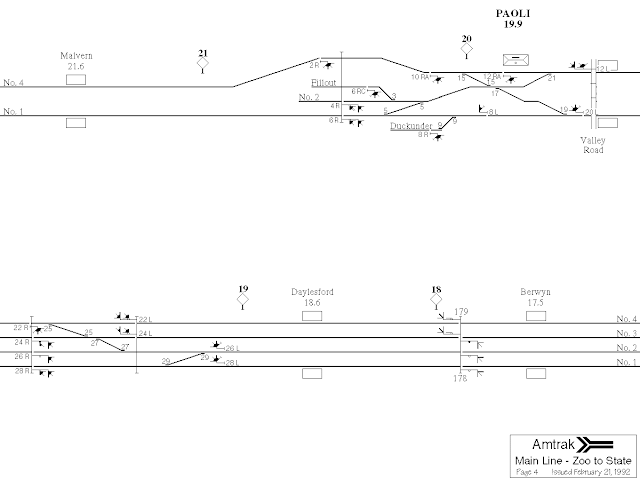Last year ago I wrote an article on how the DART light rail system in Dallas used two distinct signaling methods. Automatic Block Signals with Automatic Train Stop were used on the original Red and Blue lines built in the 1990's and audio frequency Cab Signals without intermediate wayside signals on the Green and Orange lines built since 2000. However there is a third method first used on the initial segments and most recently employed on the Blue Line extension to Rowlett. This method is Line of Sight operation and while I had seen the signs, I did not fully learn what it signified until I recently had the opportunity to ride the southern portions of the Red and Blue lines that make the most use of Line of Sight.
Line of Sight territory is exactly what it says on the tin. Trains must proceed able to stop short of any obstruction including other LRV's, pedestrians, motor vehicles, traffic lights, etc. It is governed by the following section in the DART rulebook.
Line-of-Sight Operation:
4120 Line - of -Sight Territory Incorporates mainline tracks not
protected by ABS/CST. Line-of-sight territory incorporates
the following:
- West Oak Cliff Branch - Zoo Station to end of line
at Westmoreland Station.
- South Oak Cliff Branch - Morrell Station to end of
line at Ledbetter Station.
- Central Business District - Houston Street to Pearl
Station.
- Rowlett - Signal G1813 to Rowlett Station
4121 Line of Sight Speed Trains must operate at a speed which
will enable the train operator to stop short of any
obstruction. All special instructions or posted speed zones
must be complied with. Speed shall be reduced when
adverse operating conditions exist, (i.e.) poor weather.
4122 Minimum Separation Trains must maintain a minimum
separation of at least two LRV lengths unless authorized by
the controller or when a train is stored in the tail track.
a. No more than one train at a time in the same direction
may occupy a city block in the CBD unless authorized
by the controller.
When I first encountered Line of Sight Operation at the Garland station on the Blue Line it was accompanied by a two aspect signal that I surmised was part of a low cost go/no-go ABS signaling system. From the overhead and street view I could identify other signal signals along the line and it seemed that LRV's would approach each prepared to stop within Line of Sight.
It turns out I was only partly correct as these Block Indication signals have their own alternate method of operation. On the two southern routes, Block Indicator signals can work in conjunction with Start Block (SB) and End Block (EB) signs. Passing Block Indicator with an SB triangle the train is protected by track circuit block until the following EB triangle. I am not entirely sure if the SB is needed before any EB, but that seems to be how it was set up.

The Block Indicators are used where there are line of sight issues like curves and steep overpasses so that LRV's don't have to crawl on these stretches of track. On the straight and level trains are able to travel on line of sight up to a speed of 45mph. This is of course quite safe as the LRV's are designed to run in traffic and have magnetic track brakes for bus like stopping. When exiting the ABS territory that proceed the Line of Sight territory LRV's receive an "Approach" class indication before the LoS territory sign.
 |
SEPTA two aspect block signals on the Route 102
|
The DART Line of Sight system is similar to the two aspect signals used on SEPTA's Routes 101 and 102 suburban trolleys, although in that case the signals partly work as a more formal two aspect ABS system. DART Line of Sight allows higher speeds on stretches of track located on median rights of way or city streets governed by traffic signals. It is worth noting that at least at the time of writing DART trains are scheduled such that only one LRV is expected to be in any LoS section at a time. For example a Red Line train departing Westmoreland is scheduled to enter ABS territory in 11 minutes and the maximum headway is 15 minutes.
DART's Line of Sight system is a safe and innovative way to achieve cost reductions and enable Light Rail style in street or street adjacent operation with traffic and other non-interlocked signaling. Thanks to the straight jacket of PTC, non-FRA regulated light rail systems are the only place that are able to employ outside the box signaling and safety solutions.









